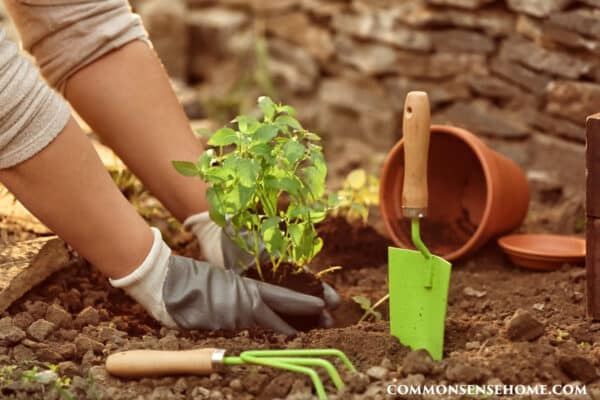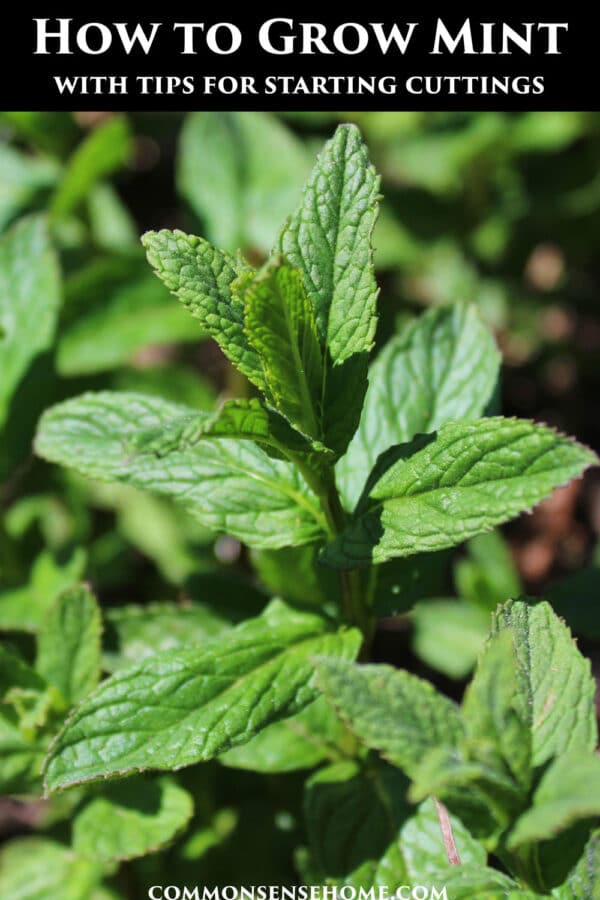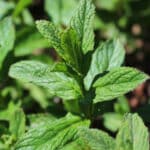How to Grow Mint Plants (with Tips for Starting Cuttings)
Mint plants are easy to grow and useful in the kitchen and medicine cabinet. I love using them as a ground cover and companion plants, too. We share how to grow mint, with tips for propagating, care, and harvest.

Types of Mint
Mint comes in various varieties, each with its unique flavor and aroma. The mint family (Lamiaceae) includes more than 7000 species and 230 genera. Many common culinary and medicinal herbs, including basil, oregano, lemon balm, and sage are in the mint family.
Some popular types of mint include:
- peppermint (mentha piperita) – classic, bold “candy cane” flavor
- spearmint (mentha spicata) – mild and sweet, most frequently used for cooking
- chocolate mint (Mentha × piperita ‘Chocolate Mint' – a type of peppermint, smells like a chocolate peppermint patty)
- pineapple mint (Mentha suaveolens ‘Variegata') – a type of apple mint with variegated leaves, fruity, minty flavor with a hint of pineapple
Note: It's possible to grow mint from seed, but not every seed will grow a plant that's the same quality as the parent. Starting with a cutting or division from a particularly fragrant plant will give you the best results.

How to Grow Mint
Mint plants thrive in full sun or part shade. Chose well-drained, fertile soil with a slightly acidic to neutral pH.
- Prepare the Soil: Work organic matter, such as compost, into the soil to improve drainage and fertility. (Alternatively, prepare your container for growing indoors or out.)
- Planting: If you're starting with seeds, sow them about 1/4 inch deep in the soil. For cuttings or divisions, plant them about 18 to 24 inches apart to allow sufficient space for spreading.
- Watering: Keep the soil consistently moist, but not waterlogged. Mint prefers slightly damp conditions.
Most mints grow as a hardy perennial, though some types are more frost tender. (I can still harvest fresh chocolate mint late in the growing season after temps drop into the 20s overnight.)
Mint makes a great companion plant for in the garden and orchard. The mint oils help deter pests, so clip back plants regularly to release the oils, and spread some of the crushed leaves around in the garden.
Caring for Mint
Mint is a relatively low-maintenance herb, but there are a few key care tips to ensure optimal growth:
- Watering: Mint appreciates regular watering, especially during dry periods.
- Mulching: Apply a layer of mulch around the mint plants to retain moisture, suppress weeds, and regulate soil temperature.
- Fertilizing: Mint generally doesn't require heavy feeding. Apply a balanced fertilizer in the spring to support growth.
- Pruning: Regular pruning is essential to prevent mint from becoming too leggy and to encourage bushier growth. Pinch off the tips regularly, and trim the plant back to about one-third of its height if it becomes too unruly.
How to Keep Mint from Spreading
Mints are aggressive growers, so it's a good idea to plan ahead to keep it from taking over the garden. I like to plant mine where we can use it as groundcover and mow around it. We also use it in the orchards to attract pollinators.
To manage it in the garden, plant mint in a pot with drainage holes, and then sink the pot into the soil. You can also try raised beds or root barriers to keep it from spreading, or grow mint in containers.
Growing Mint from Cuttings – 2 Ways
Cuttings will easily root within days, either in water, or in soil. Plants rooted in soil tend to be hardier, with little risk of transplant shock.
The best time to take cuttings to root is before flowering. Once the plant flowers, the energy goes towards the flowers instead of the roots.
To propagate in water, cut a 3-5 inch length of mint stem. The longer the stem, the better the root system. The cutting will begin to wilt right away, so have your water or pot ready before you begin. Strip the leaves from the bottom of the stem.
Put your cutting into a clear jar or vase so that you can keep track of the root progress. Immerse the stem fully in the water, but make sure that the leaves are above the water so they do not rot.
Watch for your roots to develop; the thicker roots grow stronger mint plants. Once your mint has a good root system, transplant it into to a pot with soil.
Choose a pot with good drainage, and fill it with your chosen soil. Make a hole in the soil that is large enough to not crush the roots, set your plant down into the soil, and carefully press the soil in around the stem.
The rooted cuttings may wilt some, but they should revive within a few days. Mint does like humidity, so use a spray bottle to mist periodically if you do not live in a humid climate.

Starting Mint Cuttings Directly in the Soil
For this method you need soil, a pot, and something to dig with. Use seed starting mix or good quality garden soil.
Strip the leaves from the bottom part of the stem, then dig your hole, or use a finger, or pencil to make a small hole. Next, slip your cutting down into the hole up to the leaves, and press the soil in around the stem, and water.
Remember, mint likes humidity, so if you are not in a humid area, mist your mint frequently with a spray bottle.
How to Transplant Mint
Once your mint cutting is thriving, you can begin to “harden it off”. Place it outside in a protected location with some sun for about an hour or two the first day. Each day, leave it outside a little longer. Once your plant is spending most of the day outside, plant it directly into your garden, and water well.
When you are ready to transplant, make sure to choose the right location, as mint will spread like crazy! Mint is a great to grow as a groundcover in weedy areas, as it has been known out compete even the most stubborn weeds.

Harvesting Mint
The best time to harvest mint is in the morning when the oils are most concentrated. Harvesting encourages bushier growth and a more productive plant. Clip the leaves using clean, sharp scissors or pruning shears, leaving some foliage on the plant to continue growing.
Clip off the mint just above a leaf node. This will encourage the plant to put out fresh growth from the node below the cut. When growing pineapple mint, if any branches appear with all green leaves, clip them back to ground level.
Uses of Mint
Mint is a versatile herb with a myriad of culinary and non-culinary uses:
- Culinary Uses: Add fresh grown mint leaves to salads, desserts, beverages, and savory dishes. Mint tea and tea blends are tasty and medicinal.
- Medicinal Uses: Mint has been used for centuries for its medicinal properties. It can aid digestion, relieve headaches, and soothe respiratory issues.
- Aromatherapy: Crushed mint leaves release a refreshing aroma that can be used for aromatherapy. Place them in a bowl or sachet for a natural air freshener.
For more ways to use your home grown mint, see:
How to Use Mint Leaves for Food, Medicine & More
How to Make Chocolate Mint Extract

This article is written by Laurie Neverman. Laurie and her family have 35 acres in northeast Wisconsin where they grow dozens of varieties of fruiting trees, shrubs, brambles, and vines, along with an extensive annual garden. Along with her passion for growing nutrient dense food, she also enjoys ancient history, adorable ducks, and lifelong learning.




